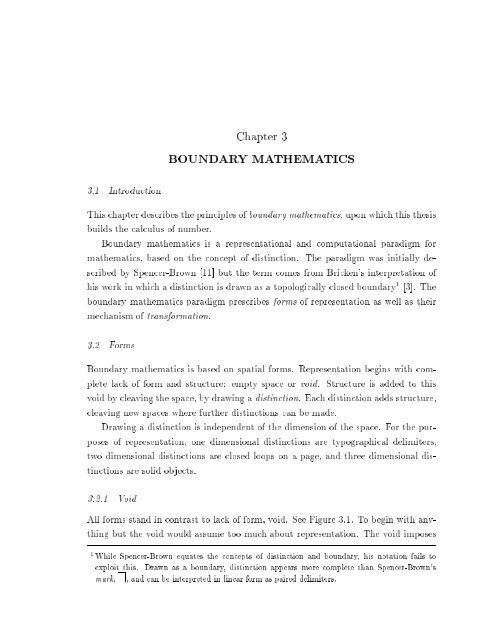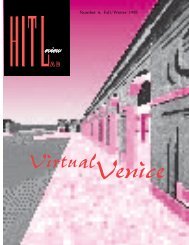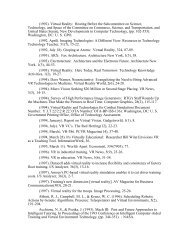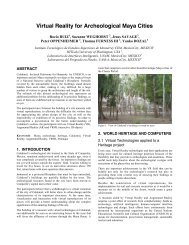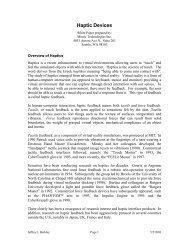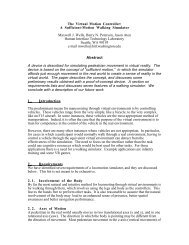A Calculus of Number Based on Spatial Forms - University of ...
A Calculus of Number Based on Spatial Forms - University of ...
A Calculus of Number Based on Spatial Forms - University of ...
You also want an ePaper? Increase the reach of your titles
YUMPU automatically turns print PDFs into web optimized ePapers that Google loves.
Chapter 3<br />
BOUNDARY MATHEMATICS<br />
3.1 Introducti<strong>on</strong><br />
This chapter describes the principles <str<strong>on</strong>g>of</str<strong>on</strong>g> boundary mathematics, up<strong>on</strong> which this thesis<br />
builds the calculus <str<strong>on</strong>g>of</str<strong>on</strong>g> number.<br />
Boundary mathematics is a representati<strong>on</strong>al and computati<strong>on</strong>al paradigm for<br />
mathematics, based <strong>on</strong> the c<strong>on</strong>cept <str<strong>on</strong>g>of</str<strong>on</strong>g> distincti<strong>on</strong>. The paradigm was initially described<br />
by Spencer-Brown [11] but the term comes from Bricken's interpretati<strong>on</strong> <str<strong>on</strong>g>of</str<strong>on</strong>g><br />
his work in which a distincti<strong>on</strong> is drawn as a topologically closed boundary 1 [3]. The<br />
boundary mathematics paradigm prescribes forms <str<strong>on</strong>g>of</str<strong>on</strong>g> representati<strong>on</strong> as well as their<br />
mechanism <str<strong>on</strong>g>of</str<strong>on</strong>g> transformati<strong>on</strong>.<br />
3.2 <strong>Forms</strong><br />
Boundary mathematics is based <strong>on</strong> spatial forms. Representati<strong>on</strong> begins with complete<br />
lack <str<strong>on</strong>g>of</str<strong>on</strong>g> form and structure: empty space or void. Structure is added to this<br />
void by cleaving the space, by drawing a distincti<strong>on</strong>. Each distincti<strong>on</strong> adds structure,<br />
cleaving new spaces where further distincti<strong>on</strong>s can be made.<br />
Drawing a distincti<strong>on</strong> is independent <str<strong>on</strong>g>of</str<strong>on</strong>g> the dimensi<strong>on</strong> <str<strong>on</strong>g>of</str<strong>on</strong>g> the space. For the purposes<br />
<str<strong>on</strong>g>of</str<strong>on</strong>g> representati<strong>on</strong>, <strong>on</strong>e dimensi<strong>on</strong>al distincti<strong>on</strong>s are typographical delimiters,<br />
two dimensi<strong>on</strong>al distincti<strong>on</strong>s are closed loops <strong>on</strong> a page, and three dimensi<strong>on</strong>al distincti<strong>on</strong>s<br />
are solid objects.<br />
3.2.1 Void<br />
All forms stand in c<strong>on</strong>trast to lack <str<strong>on</strong>g>of</str<strong>on</strong>g> form, void. See Figure 3.1. To begin with anything<br />
but the void would assume too much about representati<strong>on</strong>. The void imposes<br />
1 While Spencer-Brown equates the c<strong>on</strong>cepts <str<strong>on</strong>g>of</str<strong>on</strong>g> distincti<strong>on</strong> and boundary, his notati<strong>on</strong> fails to<br />
exploit this. Drawn as a boundary, distincti<strong>on</strong> appears more complete than Spencer-Brown's<br />
mark, , and can be interpreted in linear form as paired delimiters.


